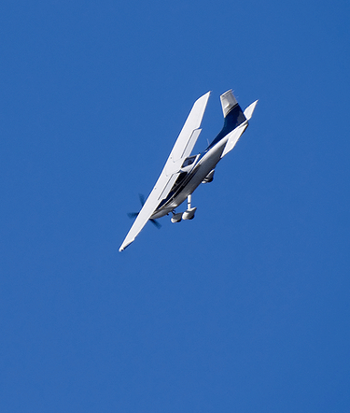Subscriber question:
"If you have a critical situation that requires the fastest possible descent, what is the best method for making an emergency descent in a single engine airplane?" - Johnathan M.
Wally:
 “This is a very good question because if you really need to do one your life may depend upon your ability to do it correctly. It is also a great question because the private pilot practical test now requires private pilot applicants to demonstrate this maneuver. Previously it was required only for commercial and higher pilots.
“This is a very good question because if you really need to do one your life may depend upon your ability to do it correctly. It is also a great question because the private pilot practical test now requires private pilot applicants to demonstrate this maneuver. Previously it was required only for commercial and higher pilots.
Let’s start with defining what we want to do. Emergency descent means we want to get on the ground as quickly as possible. We have a big problem like an engine fire or smoke in the cabin or some other very serious problem.
OK, now it is time to dig out that pilot operating handbook to see what it says. If there is a procedure there, that will be the best way to do it. You can bet that the manufacturer has tested the various ways and found the best one. So now you need to memorize it because if your pants are on fire, you won’t want to be looking around for the handbook.
Here is a little problem; many of the airplanes we fly do not have a published procedure, so we have to make one up. Actually, there are only a few things to consider so let’s look at them.
Naturally, we will close the throttle as a first step. If your airplane has a constant speed propeller you should select high RPM or flat pitch. Then comes the decision, should I slow to gear and flap speed or descend clean at red line? If you have no retractable gear or flaps this is an easy one. If you do have retractable gear and/or flaps, you need to first try slowing to gear speed and then descending at maximum gear speed while checking your rate of descent. Then try it again with both gear and flaps out and at maximum flap speed, usually a slower speed but a lot more drag.
Some pilots are reluctant to practice these maneuvers because they feel it is not good for the engine to cool off rapidly and they can be correct. However, there is no reason you can’t do these tests while maintaining some power on the engine rather than closing the throttle all the way. As long as you keep the power the same for all the tests your results should be accurate.
Whatever method works in your airplane, rolling into a steep bank will also increase the load factor on the airplane and increase the rate of descent. Not only that but it provides a good way to clear the area below you as you descend.
Then there is also the slip. In some airplanes, this is the only tool available. Slipping increases the drag and therefore increases the rate of descent. Since drag increases by the square of the speed, the faster airspeed you can use in the slip the greater rate of descent you can achieve.
So the bottom line is, know and practice the emergency descent procedure if you have a published procedure. If not, you need to experiment a bit to find out what works best for your airplane.”
